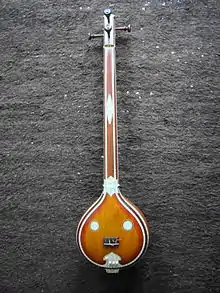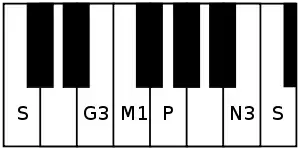| Carnatic music |
|---|
 |
| Concepts |
| Compositions |
| Instruments |
|
| Arohanam | S G₃ M₁ P N₃ Ṡ |
|---|---|
| Avarohanam | Ṡ N₃ P M₁ G₃ S |
Gambhiranata is a rāga in Carnatic music (musical scale of South Indian classical music) and Yakshagana where it is called Naati. It is an audava rāgam (or owdava rāga, meaning pentatonic scale). It is a janya rāga (derived scale), as it does not have all the seven swaras (musical notes). Gambhiranata is also known as Shuddha Nata.[1]
Structure and Lakshana

Gambhiranata is a symmetric rāga that does not contain rishabham or dhaivatam. It is a pentatonic scale (audava-audava ragam[1][2] in Carnatic music classification – audava meaning 'of 5'). Its ascending and descending scale structure (ārohaṇa-avarohaṇa) is as follows:
- ārohaṇa : S G₃ M₁ P N₃ Ṡ[lower-alpha 1]
- avarohaṇa : Ṡ N₃ P M₁ G₃ S[lower-alpha 2]
The notes used in this scale are shadjam, antara gandharam, shuddha madhyamam, panchamam and kakali nishadam (see swaras in Carnatic music for details on below notation and terms). Gambhiranata is considered a janya rāgam of Chalanata, the 36th Melakarta rāgam, though it can be derived from 8 other melakarta rāgams, by dropping both rishabham and dhaivatam.
Popular compositions
Gambhiranata rāgam lends itself for elaboration due to the pentatonic nature and symmetricity of the scale. The mallari tune played in Nadhaswaram at temple processions are set to this musical scale.[2] Here are some compositions set to this scale.
- Mudadinda Ninna kondaduvenu: ancient traditional invocation song in Yakshagana.
- Sri jalandharam composed by Jayachamaraja Wodeyar
- Jayadevaki kishora by Swati Tirunal
- Tiru Tiru Javarale By Annamacharya
- Sharanambe vani by Purandaradasa
- Enu Sadhana Madi By Bannanje Govindacharya
- Ini aedu kavalai by Periyasaamy Thooran
- Varnam – Amma Anandadayini by M. Balamuralikrishna
- Girijaramana by Mysore Vasudevachar
- Kalinga Narthana Thillana and Sri Vighna rajam bhaje- Othukkadu venkata kavi
Film songs
Language: Tamil
Related rāgams
Graha bhedam
Gambhiranata's notes when shifted using Graha bhedam, yields another pentatonic rāgam, Bhupalam. Graha bhedam is the step taken in keeping the relative note frequencies same, while shifting the shadjam to the next note in the rāgam. For more details and illustration of this concept refer Graha bhedam on Gambhiranata.
- Amritavarshini is a rāgam which has prati madhyamam in place of the shuddha madhyamam. See below table for more details.
- Hamsadhvani is a rāgam which has chathusruthi rishabham in place of the shuddha madhyamam. See below table for more details.
| Rāgam | Śruti Tonic | C | D | E | F | G | A | B | C | |||||
|---|---|---|---|---|---|---|---|---|---|---|---|---|---|---|
| Gambhiranata | C | S | G3 | M1 | P | N3 | S' | |||||||
| Amritavarshini | C | S | G3 | M2 | P | N3 | S' | |||||||
| Hamsadhvani | C | S | R2 | G3 | P | N3 | S' |
Grahabedam
| Rāgam | C | D | E | F | G | A | B | C | ||||||
|---|---|---|---|---|---|---|---|---|---|---|---|---|---|---|
| Gambhiranata | S | G3 | M1 | P | N3 | S' | ||||||||
| Bhupalam | D1, | S | R1 | G2 | P | D1 | ||||||||
| Hamsanadam | P, | N3 | S | R2 | M2 | P | ||||||||
| M1, | D2 | N2 | S | G3 | M1 | |||||||||